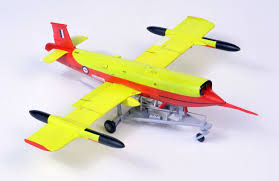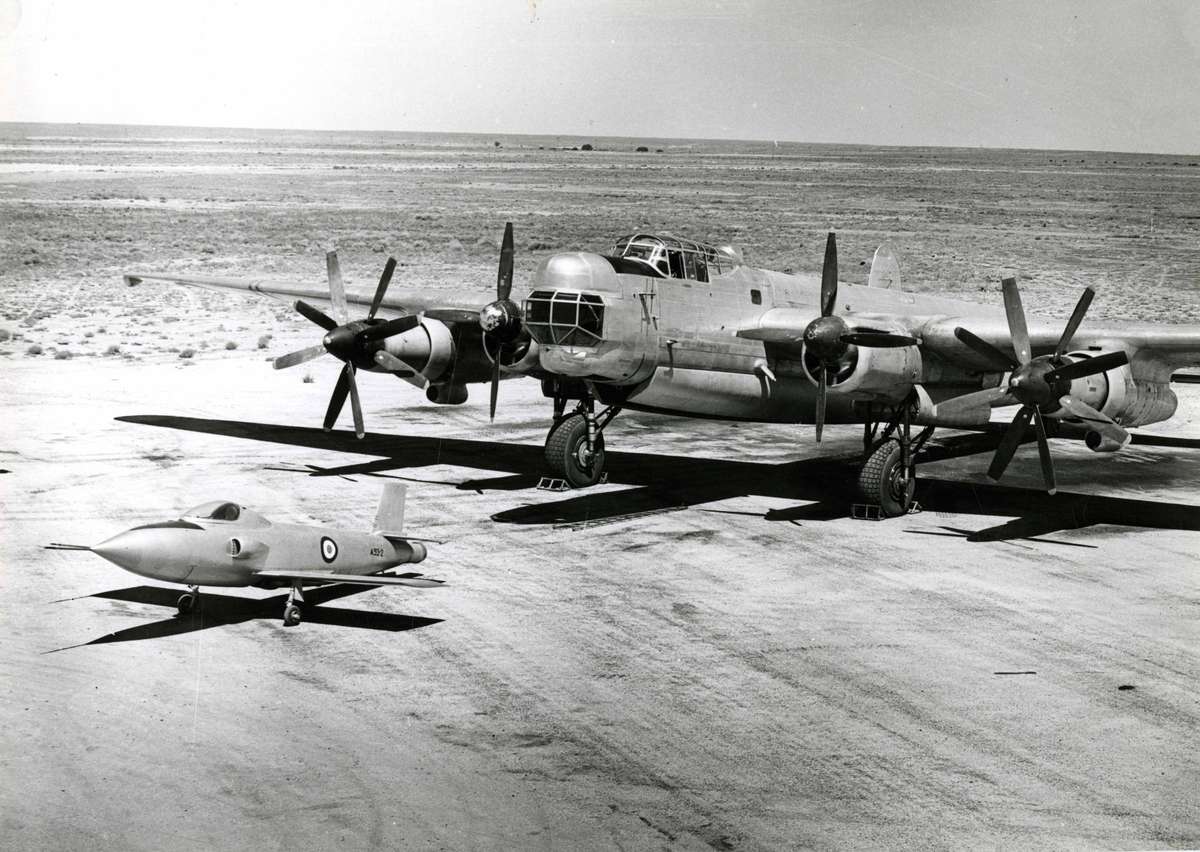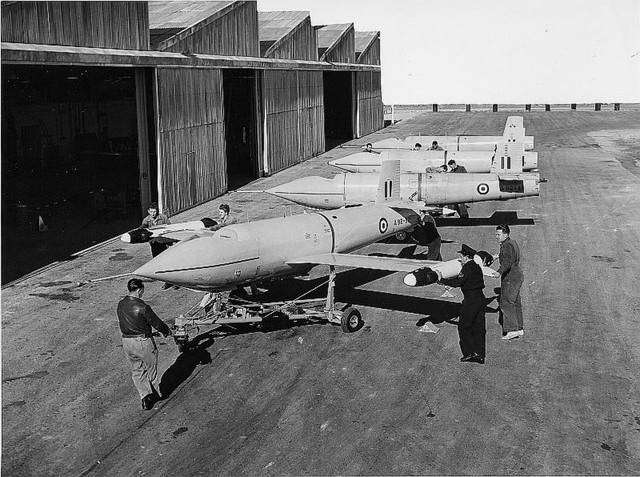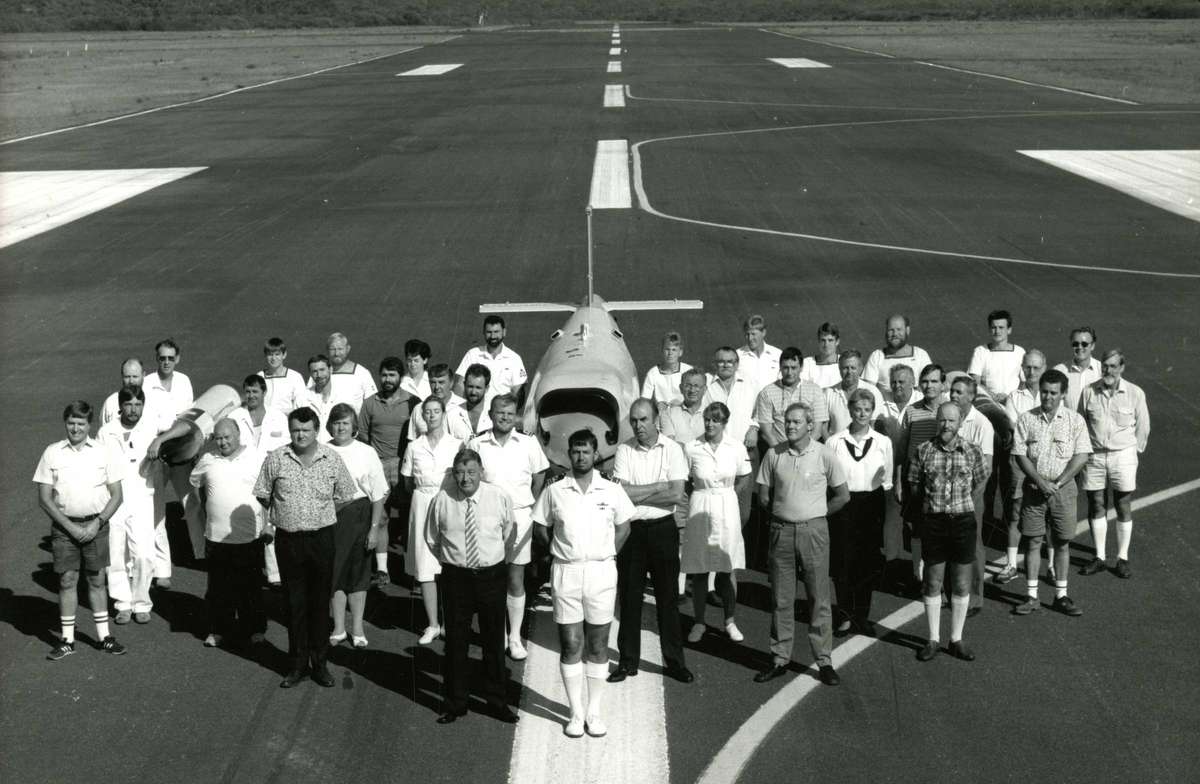GAF Jindivik Pilotless Target Aircraft
The Jindivik was a target drone developed as a result of a bilateral agreement between Australia and the UK regarding guided missile testing. While the UK provided the missiles, Australia provided test facilities, such as the Woomera Test Range. As a result of the agreement, Australia gained the contract for developing an unmanned target aircraft capable of a 15-minute sortie at 40,000 ft.
Jindivik Videos:
Australia Builds Robot Plane (1952). A short Pathe News excerpt showing the Jindivik being built.
Record For Pilotless Plane. Short British film about Jindivik’s reliability. Good vision of take off and landing.
Llanbedr. Jindivik hit by Sidewinder Missile off Harrier. Good aerial footage by chase aircraft.
Record of RAN Jindiviks. Courtesy of ADF Serials
| N11-495 | Mk.203A | Previously A92-495. Delivered 23/10/66. Shot down by Missile 25/05/67. |
| N11-496 | Mk.203A | Previously A92-496. Delivered 22/11/66. Shot down by Gunfire 06/03/73. |
| N11-502 | Mk.203A | Previously A92-502. Delivered 23/12/66. Shot down by Missile 07/03/67. |
| N11-505 | Mk.203A | Previously A92-505. Delivered 21/06/67. Shot down by Missile 06/03/68. |
| N11-518 | Mk.203A | Previously A92-518. Delivered 05/08/67. Crashed after Malfunction 02/08/58. |
| N11-522 | Mk.203A | Previously A92-522. Delivered 27/03/68. Shot down by Missile 03/03/72. |
| N11-527 | Mk.203A | Previously A92-527. Delivered 06/05/68. Crashed after Malfunction 19/02/69. |
| N11-530 | Mk.203A | Previously A92-530. Delivered 25/10/68. Crashed after Malfunction 11/09/87. |
| N11-531 | Mk.203A | Previously A92-531. Delivered 19/11/68. Crashed after Malfunction 30/06/69. |
| N11-532 | Mk.203A | Previously A92-532. Delivered 04/06/69. Shot down by Gunfire 15/11/69. |
| N11-538 | Mk.203A | Previously A92-538? |
| N11-603 | Mk.203B | Previously A92-603. Delivered 10/69. Damaged by Missile, crashed landing 18/12/65. |
| N11-609 | Mk.203B | Previously A92-609. Delivered 10/69. Crashed after Malfunction 13/09/71, damaged but returned to service. On display at Australia’s Museum of Flight, Nowra NSW. Constructors plates (there were 2), show it as c/n FR6. |
| N11-636 | Mk.203B | Delivered 04/03/70. Crashed after Malfunction 13/09/71. |
| N11-637 | Mk.203B | Delivered 04/01/72. Shot down by Missile 07/04/74. |
| N11-638 | Mk.203B | Delivered 04/01/72. Shot down by Missile 04/12/75. |
| N11-639 | Mk.203B | Delivered 29/05/72. Crashed after Malfunction 21/08/73. |
| N11-640 | Mk.203B | Delivered 13/07/73. Shot down by Missile 15/02/84. |
| N11-641 | Mk.203B | Delivered 17/01/74. Crashed Jervis Bay 14/03/74. |
| N11-642 | Mk.203B | Delivered 21/08/74. Damaged 02/09/74. Crashed after Malfunction 28/01/82. |
| N11-643 | Mk.203B | Delivered 02/12/74. Crashed 23/08/77. |
| N11-644 | Mk.203B | Delivered 09/12/74. Crashed after Malfunction. |
| N11-645 | Mk.203B | Delivered 19/10/75. Crash landing Jervis Bay 08/11/76. |
| N11-646 | Mk.203B | Delivered 27/11/75. Crashed 17/01/77. |
| N11-647 | Mk.203B | Delivered 27/09/76. Shot down by Missile 13/09/83. |
| N11-648 | Mk.203B | Delivered 28/09/77. Crashed 29/03/83. |
| N11-649 | Mk.203B | Delivered 24/10/77. Shot down by Missile 24/07/79. |
| N11-650 | Mk.203B | Delivered 27/02/78. Shot down by Missile 27/09/86. |
| N11-741 | Mk.203B | Delivered 13/12/83. |
| N11-742 | Mk.203B | Delivered 13/12/83. Named ‘Vic Harvey’. Flew last Jindivik mission 26/06/98.Stored in the open at Jervis Bay 2000. |
| N11-743 | Mk.203B | Delivered 13/12/83. Named ‘David Manolas’, Stored in the open at Jervis Bay 2000. Acquired by the National Aviation Museum in 2011 and will be used as spares to complete the construction of A92-492. |
| N11-744 | Mk.203B | Delivered 13/12/83. Shot down by Missile 16/07/87. |
| N11-745 | Mk.203B | Delivered 03/08/88. Damaged landing 27/01/89.Stored in the open at Jervis Bay 2000. |
| N11-746 | Mk.203B | Delivered 05/02/89. Shot down by Missile 05/07/89. |
| N11-747 | Mk.203B | Delivered 16/06/89. |
| N11-748 | Mk.203B | Delivered 10/04/90. Named ‘Paul Gomma’, Stored in the open at Jervis Bay 2000. |
| N11-749 | Mk.203B | Delivered 11/85. Named ‘LCDR A G McDonough’, Stored in the open at Jervis Bay 2000. |
| N11-750 | Mk.203B | Delivered 12/85. Was on outdoor display at Jervis Bay Range Facility. Now at Restoration Hanger Fighterworld, NSW. |
| N11-751 | Mk.203B | Delivered 25/08/87. Crashed 29/10/88. |
| N11-752 | Mk.203B | Delivered 16/02/87. Crashed on take-off Jervis Bay 25/05/92. Was held by Australia’s Museum of Flight, Nowra NSW, in Storage. Held by South Australian Aviation Museum. |
| N11-800 | Mk.104B | Previously A92-608. Delivered 03/81.Flight trials 05/81 to 07/81 then in storage. |
| N11-801 | Mk.104B | Previously A92-736. Delivered 03/82.Flight trials 04/82 to 05/83.Crashed 05/83 into sea off Jervis Bay. |
Development of the Jindivik began in 1948, with the first flight of the manned derivative in 1950 (known as the Pika) and the first flight of the unmanned version (Jindivik) in August two years later.
The Pika first flew in October 1950 from Woomera airfield. Known initially as Project ‘C’, two Pikas were built and logged over one hundred flying hours in testing. To date the only Australian designed and built manned jet aircraft, only one survived (A93-2 in the RAAF Museum in Point Cook) which ended its flying career in June 1954.
The Pika was powered by a single Armstrong Siddeley Adder turbojet, and had a maximum speed of over 755 km/h. Differing from the Jindivik in its engine intakes, undercarriage and cockpit, the addition of the pilot reduced the fuel load available for the aircraft, reducing its endurance to around 30 minutes. In addition, the aircraft could be both flown by the pilot or a ground station and provided excellent training for operators of the subsequent Jindivik with the added safety net of a pilot in the cockpit. Although the Pika suffered several minor accidents, the trials were a success, and among other results, proved that the Jindivik design did not require a rudder, saving cost and weight.
Above: A rare photograph of two test aircraft at Woomera, sometime between 1951 and 1954. The second of the two Pikas can be seen in the foreground. Below: Pika C2 with one of the first Jindiviks. (Photos: FAA Museum)
 The Jindivik (the Aboriginal word for ‘hunted one’) followed the same basic form as the Pika except it had a single skid instead of an undercarriage and a dorsal air intake located where the Pika’s cockpit was. The Jindivik Mk.1 was powered by an Armstrong Siddeley Adder (ASA.1) turbojet, which had been developed as a disposable engine for the project. Only 14 Mk.1s were ever made.
The Jindivik (the Aboriginal word for ‘hunted one’) followed the same basic form as the Pika except it had a single skid instead of an undercarriage and a dorsal air intake located where the Pika’s cockpit was. The Jindivik Mk.1 was powered by an Armstrong Siddeley Adder (ASA.1) turbojet, which had been developed as a disposable engine for the project. Only 14 Mk.1s were ever made.
The Mk.2 was powered by a 1,640 lb Armstrong Siddeley Viper engine. This engine was designed for a short lifespan – about 10 hours, but a “long life” version was also produced for conventional aircraft.
The control systems were manufactured by various firms including Elliott Brothers, GEC and McMichael, with assistance from the Royal Aircraft Establishment. Control was maintained through an autopilot that received radio commands from the ground, rather than direct flight by a ground controller. Eighteen commands could be issued to the autopilot with six further commands for the operation of other onboard equipment. The drone was launched via a self-steering trolley. At 110 knots, the drone applied its flaps, pushed the elevators up and released from the trolley. Landing was made at 150–125 knots. Two controllers (azimuth and elevation) were used to align the drone on the runway. On landing it touched down on its skid and banking would cause the wingtip “shoes” to touch the runway, which controlled its path down the runway as it slowed.
Jindivik Mk.2s A92-52, 41, 49 & 39. A.T.U., Woomera, c.1955, via Mike Mirkovic.
Between 1952 and 1986, a total of 502 aircraft were built by the Government Aircraft Factory in Melbourne for use mainly by the RAF, RAAF and RAN, although a small number also went to Sweden and the USA.
 The RAN operated a total of 42 of the Jindivik Mk.203A & B series target aircraft from 1966 until 1998. These were based at Jervis Bay Range facility and were used for live missile and gunnery practice. Its major role was crew training, mainly with Seacat and Tartar missiles, but also for Sidewinder air-to-air missiles carried by the RAN’s Skyhawk jet fighter-bombers. Elusive and fitted with counter measures it could effectively simulate an enemy missile or aircraft attack.
The RAN operated a total of 42 of the Jindivik Mk.203A & B series target aircraft from 1966 until 1998. These were based at Jervis Bay Range facility and were used for live missile and gunnery practice. Its major role was crew training, mainly with Seacat and Tartar missiles, but also for Sidewinder air-to-air missiles carried by the RAN’s Skyhawk jet fighter-bombers. Elusive and fitted with counter measures it could effectively simulate an enemy missile or aircraft attack.
Originally designed as an expendable target the Jindivik’s features and reliability enabled it to fly many times without being destroyed. It had an excellent speed and high altitude performance; including low-level flight over the sea, and could trail smoke, also tow IR/RF decoys and flares to avoid destruction during live firings.
For special tasks the RAN N11 Jindivik Mk. 203A & B series could be modified with wing pods and wing extensions. Powered by a 1134 kg (2,500 lb) thrust Bristol Siddeley Viper 201 turbo jet (Rolls-Royce from 1966), it had a maximum speed of 490 knots (limit Mach 0.86), a Service ceiling of 57,000 ft and a range of 540 nm. Width with pods and wing extensions 7.92 m; Length 7.11 m; Height (on launch trolley) 2.59 m.
Above. The Jindivik Team – date unknown. Below: Preparing an aircraft for flight. (Both photographs courtesy of FAA Museum)
In the early 60’s work commenced on a replacement for the Jindivik to be called the Turana. Designed as a derivative of the Ikara anti-submarine missile, the project failed, however, and the Jindivik soldiered on until 1998 when it was finally replaced by the BAE Kalkara unmanned aerial target.
From Kim
GAF Jindivik Pilotless Target Aircraft
The RAN operated a total of 42 of the N11 Jindivik Mk.203A & B series target aircraft from 1966 until 1998. These remote controlled target aircraft, based at Jervis Bay Range facility, were used for live missile and gunnery practice. Manufactured by the Government Aircraft Factory, Melbourne, the Jindivik was originally designed for the British Ministry of Supply. Its performance and reliability led to large orders from Australian and the U.K., with small numbers exported to Sweden and the USA.
Jindivik is the Aboriginal word for ‘hunted one.’ Its major role in the RAN was for crew training, mainly with Seacat and Tartar missiles, including the RAN’s Skyhawk jet fighter-bombers using Sidewinder air-to-air missiles; also with RAAF Mirage jets firing Matra and Sidewinder missiles. Elusive and fitted with counter measures it could effectively simulate an enemy missile or aircraft attack.
Jindivik operated via a radio link from a control centre and was launched from a runway, from a steerable trolley, and returned to land on a retractable skid. Originally designed as an expendable target the Jindivik’s features and reliability enabled it to fly many times without being destroyed. It had an excellent speed and high altitude performance; including low-level flight over the sea, and could trail smoke, also tow IR/RF decoys and flares to avoid destruction during live firings.
For special tasks the RAN N11 Jindivik Mk. 203A & B series could be modified with wing pods and wing extensions. Powered by a 1134 kg (2,500 lb) thrust Bristol Siddeley Viper 201 turbo jet (Rolls-Royce from 1966), it had a maximum speed of 908 km/h (490 knots); limit Mach 0.86; Service ceiling 17,375 m (57,000 ft); Range 1,000 km (540 nm, 621 miles); Width with pods and wing extensions 7.92 m (26 ft. 6 in.); Length 7.11 m (23 ft. 4 in.); Height (on launch trolley) 2.59 m (8 ft. 6 in.).
In 1998, after 32 years in service, the RAN withdrew the Jindivik – replacing it with the BAE Kalkara unmanned aerial target.










